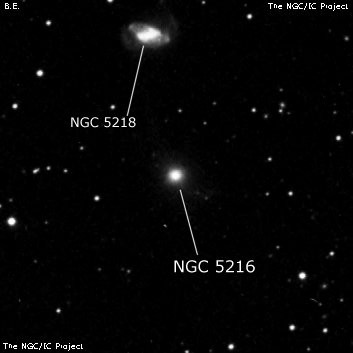
William Herschel discovered NGC 5216 = H II-841 = h1635, along with II-842 = NGC 5218, on 19 Mar 1790 (sweep 953) and logged "pB, S, iF." CH's reduced position is 2' northeast of UGC 8528. JH measured an accurate position for h1635, but thought it was a new object, as he applied II-841 to NGC 5218. The identifications were corrected in GC and NGC, but still the MCG has NGC 5216 and 5218 reversed.
The nickname "Keenan's System" derives from a 1935 paper "An Unusual Pair of Nebulae: NGC 5216 and 5218" (in 1935ApJ....81..355K). Keenan announced that based on a Yerkes 24-inch plate "these two apparently well-separated galaxies are connected by a faint but definite band of nebulosity... The case is striking, among the small number of pairs known to be physically connected, because of the considerable separation of the two objects in proportion to their size." The paper included a photograph of the system. Zwicky used the name "Keenan's System in his 1956 paper "Multiple Galaxies" on interacting galaxies (http://articles.adsabs.harvard.edu/full/1956ErNW...29..344Z). The filament connecting the galaxies stretches 22,000 light years long.
400/500mm - 17.5" (5/23/98): smaller and fainter of pair with NGC 5218 4.0' N (Keenan's System = interacting on long exposure photos). Fairly faint, round, 1.0' diameter. The core is 15" in diameter at 280x.
900/1200mm - 48" (4/20/17): bright, moderately large, slightly elongated, sharply concentrated with an intense nucleus surrounded by a small bright core and a moderately large halo.
Notes by Steve Gottlieb